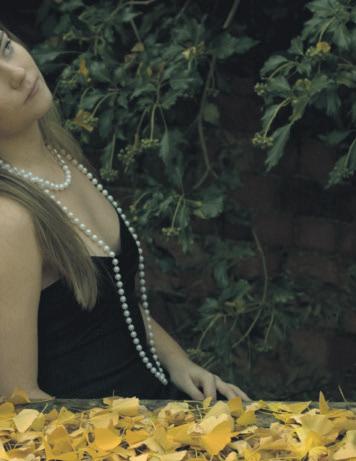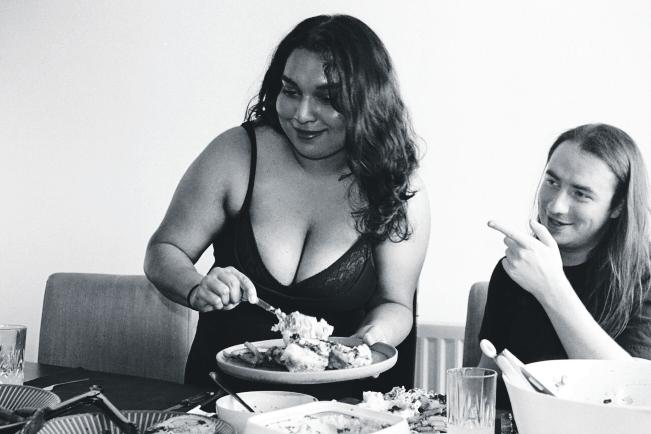THE CROFT









Welcome to our final edition of The Croft for this year, 2022. It seemed only fitting that, given the timing of the issue, we go out with a bang and highlight all things joyous, glamourous and celebratory. .
So, we’re bringing you a wide range of feel good content, from dinner party tips, to being aussred in your evening attire. From negroni reviews to an international perspective on festive celebrations from around the globe. Whatever it is you’re commemorating this year, even if that’s just being here, we’re here to celebrate with you.




Thank you once again to our brilliant editroial and creative teams. We are consistently blown away by your hard work, dedication, talent and creativity, and we can’t wait to see what next year brings. Stay tuned for even more exciting content, collaborations and changes coming in 2023.
Emily & Nicole x




In a garden of greenery and sunset pending at 16.32pm, you are cordially invited to a moment in dusk, opulence in the dimmer hours of the incoming evening. An exploration into allure, frondescence and hauteur. Meet us at sundown.

 Emily Fromant Nicole Quy
Models Saiba Haque Eve Baird
Emily Fromant Nicole Quy
Models Saiba Haque Eve Baird






Throughout time, fashion has long been a form of self-expression. Pieces of clothing are tied to our sense of self. Whether it’s an art form, or a specific piece attached to fond memories – fashion has always been more than just clothing.
Nowhere does this become more obvious than The Party.
Words by Emily Fromant
A staple in university culture, parties are not just a gathering of friends. From dress codes, to themes, and a desire to look your best, the party requires its very own dress code. The ambiguous phrase, ‘dressing up’, presents limitless opportunities, but sometimes only to a degree. Parties also come with the prospect of being observed. There will be photos, and new encounters, so whilst you can wear whatever you want, you also want to create a good first impression. Here, fashion becomes more than what you like to wear, it’s also what others like you to wear as well.
When I was 16, I attended my very first ‘party’. I was excited, nervous, and unsure really of what to expect. I had been to birthday parties, or the classic drinking in the local park, but the name ‘party’ felt so much more serious. When discussing the upcoming party with my WHAT WERE WE GOING TO WEAR?
This may seem like I’m making fun of my sixteen-year-old self, but I’m not. The pressure of what to wear to a party was huge. I remember some of my friends would refuse to wear the same outfit twice, buying new outfits for each occasion.
We could look upon this teenage story dramatically and roll our eyes, but my sixteen-year-old self was experiencing the true pressure of the party. Of being seen and judged by those around you.

Whilst fashion is a form of self-expression, it can also be a source of judgement. So many of us feel uncomfortable wearing certain clothes due to fear of being ‘judged’. Take our dear old ‘skinny jeans’, for example, now a source of disgust in the fashion world. Our sense of self-expression surrounding fashion has created a false sense of individuality. In a world filled with trends and ‘basic’ fashion, people are constantly striving to be authentic and individual, and judging those who are not.
The truth is: No fashion is truly individual. We are influenced by those who inspire us, even people we see in the street. And that is a beautiful thing. Whilst we shouldn’t be fearful of standing out at the party, we also shouldn’t be afraid of being a part of a trend. Whilst fashion in recent years has been celebrated as a form of art, allowing those to feel more comfortable in experimenting with fashion, we’ve also become ‘afraid’ of being basic. Fashion is just fashion, whilst important, it should never shape how we perceive someone.










First term is always overwhelming no matter what year you are in. Everyone is trying to settle back into abnormal student living. There’s studying, deadlines, and juggling social/society calendars. As Christmas looms and everyone goes their separate ways, it may seem that meeting friends between lectures for coffee was not possible. Christmas is party season, so it is the perfect opportunity to throw a dinner
I know what you’re thinking;. It’s the end of term, wwthe budget didn’t quite stretch as far and you’re clinging to the last couple weeks until January student loan replenishes your account, so how can you afford a dinner party? To make a meal stand out as special, I always go with 3 courses. This may sound expensive, but if you adapt and use ingredients that stretch across each course, you can buy in bulk, bringing down the cost.
A Christmas dinner wouldn’t be complete without a bird at the centre of my platetable. Whole chicken is the best value to buy. They are slightly less popular, so if you go to the store around 5 o’clock, there tends to be one with a lovely yellow label stuck onto it for as little as £3.50. Roast potatoes (Maris Piper) are the next must have; carrots are already secured; as much as I love parsnips the price is very inflated, so I wwould pick courgette as a backup, cauliflower cheese and redcurrant sauce. Tough decisions must be made when picking veggies, but over-complicating things will bring up the price, and bring down the cooking enjoyment.
I always tend to get over-excited and over-complicate the dessert. However, pulling off a Christmas dinner is not easy. To make life easier, I would make a dessert in advance that can sit and behave and not ruin easily. I have very little baking supplies. So, splashing out on a muffin tray is not an option. Cookies, however, make things very simple and they are delicious. It may not seem like a very special dessert, but its cookies and milk with a twist, a warm glass of mulled wine which you can buy premade for as little as £2 a bottle. Everyone loves alcohol, and it provides the A perfect sensational pairing to go with a chocolate chip cookie.
Hosting a dinner party may seem unattainable, but when you lower expectations of creating a Michelin star experience, lighting some candles, making some hand written menus and getting some Christmas music going makes for an intimate and enjoyable experience that will stay with you when looking back on university memories.



With the cold weather in mind, soup is a perfect option to warm your guests as they come through the door and sit down. I love absolutely adore carrots! They are inoffensive vegetables (and surely help you see in the dark?), plus. Moreover. I always find I buy far more than needed; they sit going limp in my fridge. This makes them the perfect starter veg to use up leftovers.as I can also use carrots as a main course side. Ginger is a favourite spice to overindulge in during the festive period. When used iIn soup, it providesgives an extra zingy kick. ; Ccarrot and ginger seem are a perfect pairing, plus youand since only need a dash of ginger is needed, so you can save the ginger for another time. The rest can be saved for another time (perhaps for your tea!).
Editor: Hannah Wright

Deputy Editor Saiba Haque
Digital Editor: Lara Inglis Jones
Sub-Editor: Emma Witham
Contrary to what Emma D’Arcy and their co-star Olivia Cooke might have us believe, the negroni, let alone sbagliatto, seems not to be the drink of choice for many. After the soundbite of D’Arcy detailing their favourite cocktail began to increase notoriety, there naturally followed a peak in interest for this timeless classic, but it was surprising to see just how many people were unaware of the drink, and even more so how many were unapproving, or at least unexpecting, of the Negroni’s punch.

For myself, like D’Arcy, the negroni will always be my go-to. It very rarely misses the mark and when done well, it comes together to create the perfect harmony of citrus, bitterness, and an earthy, herbaceous undertone. Providing a break from sweeter cocktails, the smooth, boldness of the negroni offers something palatable and highly sophisticated. This is not, of course, to discredit other cocktails, sometimes nothing will suffice quite like the tropical creaminess of a pina colada, but I have very rarely found myself in a drinking scenario where a Negroni didn’t seem like the right choice.
Certainly, it packs a punch, something which I was pleasantly reminded of upon ordering last week to be met with a fairly patronising, “Yeah? That’s a drink drink, by the way”. Ostensibly unbeknownst to me, perhaps the negroni has gained a reputation for being so strong that venues feel the need to reiterate its alcoholic content twice? Something to muse on. In fairness, many of my friends have commented that they tried a Negroni for the first time after hearing about it via TikTok, only to be, excuse the pun, bitterly disappointed at the drink’s fairly unforgiving nature. I would contend that the piquant of the original negroni is the culprit here, unsurprising given that it comprises quite literally purely of alcohol, and so making a point to specify sbagliatto may favour well for those who tend to stay away from heavier drinks.
Sbalgiatto, quite literally translating to ‘mistaken’, is a variation on the classic which utilises prosecco in place of gin (and, yes, this does mean that D’Arcy’s specification of a sbagliatto with prosecco in it, if we are to be pedantic, is actually redundant- but oh, well; it sounds sultry enough when they say it). The effervescence from the Prosecco results in a lighter, bubblier version of the drink with slightly less of an edge, perfect for those who still want to indulge in something a little less sickly, but find the combination of gin, vermouth and Campari a little too much.Whilst my loyalties will always lie with the Negroni in its unaltered form, and I, for one, believe that the current hype around the drink is truly deserved, it is understandable why, for some, the notion that the acquired taste of this Italian classic could be one’s “drink of choice” is a little perplexing.
If you’ve yet to try, there are multiple places in Bristol to get a great Negroni- let’s not forget that earlier this year Rock Salt set a record for the World’s largest Negroni - Hyde & Co and The Milk Thistle are two of my favourites, but you will find that most venues will have a Negroni on the menu, with many happy to adapt this to a sbagliatto. For a more adventurous take on the classic, try The Milk Thistle’s ‘Sweet Vengeance’, substituting citrus for raspberry and adding an additional dimension of cocoa, or Bar 44’s Padron Negroni, made from Padron pepper infused Campari, and a vermouth packed with spices known as La Copa vermut Rojo.
sbagliato /sba·glià·to/ aggettivo







Fatto male per un’esecuzione o un’impostazione chiaramente difettosa, malfatto, malriuscito.



We’re all told that university involves a lot of going out, getting drunk, and missing a lecture, in favour of a spoons breakfast to nurse the hangover. Though everyone’s experience can and will be different. At some point there will be chances of nights out, or your flatmates will be pre-drinking and holding house parties around you. So, what if that doesn’t feel like you? Because, for me, partying comes with a few problems. I have struggled with my mental health for a long time. I finally got professional help when I was suspended from university, after second year. I was not exactly a party animal before this suspension. However, going out and getting drunk had been part of my university experience and this in itself was often problematic. Many of us struggle with social anxiety. Therefore, nights out can be difficult for a lot of people. This is especially the case when we feel the pressure to get involved, or have the ‘real’ university experience (whatever that even means!). But wait. Alcohol. Instant confidence: just add vodka and stir.
One particularly rough New Year’s and days of recovery and suddenly, it just wasn’t worth it anymore. It’s not easy, though, especially when it had been a useful tool for years. When I stopped drinking I was home, in my comfort zone, and still in the momentum of the pandemic, so not socialising often. But then I went on a year abroad, which felt like repeating Freshers for months on end. New people, the same small-talk, student events. Facing social anxiety, in a foreign country, without the springboard of a few glugs of wine or a Stein of beer in hand, is not easy. And being faced with the inevitable ‘You don’t drink? Why?!’ in a country where beer is ingrained into the culture is hardly fun either.
Not drinking is still sometimes difficult now, even back home. It can come with stigma: you might worry that you’ll be seen as a ‘downer’. But it’s not about the version of yourself that other people want to be around, it’s who *you* want to be in your own head with.
You have to put yourself first.
Of course, I still get anxiety and low moods, but I can deal with this a lot more lucidly.
So, what’s my relationship with partying now?

Enter problem two. Similar to a lot of people, alcohol worsens my anxiety and low moods. I have obsessive compulsive disorder, mainly manifesting in intrusive thoughts and obsessive thinking. These ruminations were already on the soapbox of my brain most of the time, but alcohol handed them the loudspeaker. I would often feel low on a night out, like I’m on the outside, looking in on everyone. But alcohol brought on an abrupt drop in mood at some point in the night. I would get existential dread - and dread about the thoughts I was having - that would carry over into my hangover. This was next-level hangover blues I couldn’t shower off or swallow down with a strong coffee.
During my year abroad, I came to some useful realisations. Every time an opportunity to socialise would arise, I would experience turmoil over whether I should go or not - I never really felt like I wanted to. However, I would drag myself out as I didn’t want to not do something just because I was scared, and also to expose myself to my fears. As time went on, I realised that it wasn’t just anxiety that was holding me back from nights out, but that it just wasn’t my ‘thing’ anymore.
Like many of us, I would rather stay in and watch a film, or go for a meal with close friends. And that’s totally fine. You make the choice that’s best for you. There is no ‘right’ way.
As with drinking, I made an informed decision and gave myself a break. I didn’t isolate myself as I knew that my resistance to smaller gatherings was more fuelled by depression or anxiety, so I took part in these. I had awareness and became more selective of what I said yes to. When I felt up for a challenge, I would go to a bigger event.

When I came back to university, I had a deeper sense of what I wanted: fewer nights out just for the sake of it, no drinking, and more self-compassion and coping skills.
I also had a growing interest in mental health advocacy, that had been sparked during my year off. I had started a blog and Instagram page, wanting to raise awareness about mental health.
With this newfound sense of direction, I started volunteering for Bristol Nightline as a Publicity Volunteer.
Many of you will have heard of Nightline, maybe just by seeing a poster around campus or the number on the back of your U-Card. Nightline is a listening and information service, run for students, by students. Volunteers take calls and answer instant messages throughout the night during term.
We listen to students and help them to talk through their problems. We work by 5 core principles: confidentiality, anonymity, non-judgement, non-directional, and non-advisory.
Having a charity like Nightline at a university is vital because many students struggle with their mental health to varying degrees. The problems you may face are so wide-ranging, from friendship difficulties, work stress, anxiety about nights out and drinking, to more urgent health problems. But no problem is ‘insignificant’ or ‘wrong’. Always remember that you are not alone. As cliched as it sounds, someone will be going through the same thing as you. You do not need to feel ashamed of anything you might be going through, and there are always people you can talk to.
Reach out for help if you need it, and Nightline are always here to listen, over the phone or instant message.
Editor: Sophia Smith

Deputy Editor: Ursula Glendinning
Digital Editor: Helen March
Sub-Editor: Zara Whistler
PHOTOGRAPHER: Lottie Keen
MODELS: Megan Haf Lewis and Shaun Arthur
In the early hours of the morning, when the buzz dies down, and everything is still.









Digital Editor Isobel Edmondson
Deputy Editor Grace Burton
Editor Finnuala Brett
Subeditor Eve Baird
The French ‘Soirée galette des rois’ (King Cake Soirée) tradition dates to the 14th century, where friends and families would gather and celebrate to mark the Winter Solstice, before being claimed by the Church to mark the story of the Epiphany and the Three Kings at the birth of Jesus. A galette des rois is served to the President of the Republic every year and is supposed to feed a whopping 150 people.
Ah yes, a ginormous pastry to see in the new year – just when I thought France couldn’t get any Frencher.
It was my flatmate in Toulouse last year who introduced me this tradition, as she suggested we host one of these soirées galette des rois. I was confused at first as she explained the tradition, picturing a Breton galette, which is essentially a savoury crepe (I apologise to any Bretons I may have just insulted).
What my flatmate pulled out of her bag that evening was no pancake. It was a distinct mix between a puff pastry and a cake, and there was a paper crown rested on top. The most intriguing part, however, was not the galette but what was hidden among the layers.
Back in the 14th century, there would’ve been a bean lingering somewhere inside the
cake. At the soirée galette des rois, the youngest child would hide under the table, list all the who should be given the next piece of the cake. The first person to encounter the bean would get to be king or queen for the day. Since the 18th century, the bean (‘la fève) has evolved into a plastic model of some sort, which is still referred to as a bean today. We got a tiny cow figurine.
There are various interpretations of the game, and whichever rules you follow, it’s a great chance for people all ages to come together in the dark months of winter and become children again. It’s new spin on games night, combined with a deliciously sweet pastry to snack on while you play.
I was grateful to discover this tradition, especially after the buzz of Christmas and new year had died down and Blue Monday was approaching.
Maybe the party doesn’t have to end as the grind begins again, and here in the UK as exam season comes sliding in like an unsolicited text, we could take inspiration from France and host our very own soirées galette des rois.



